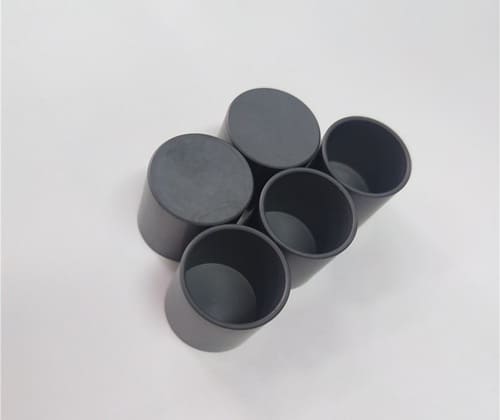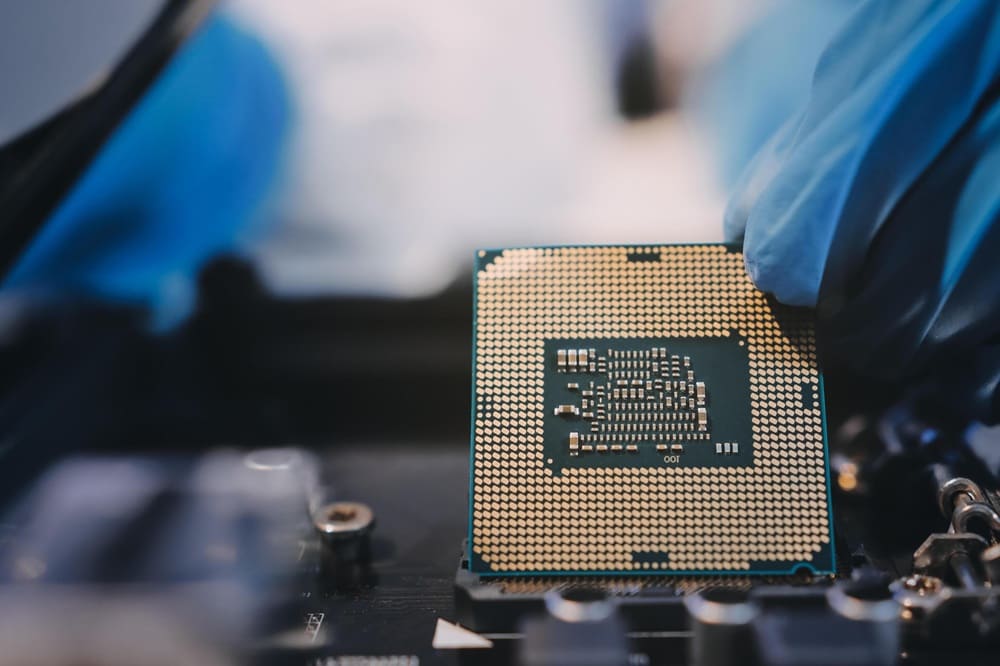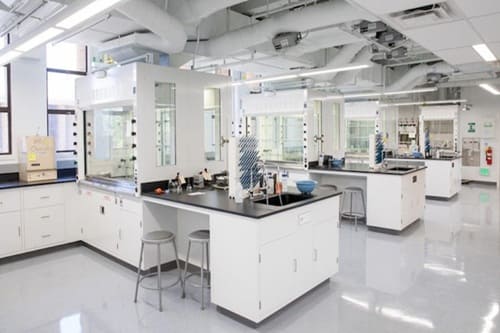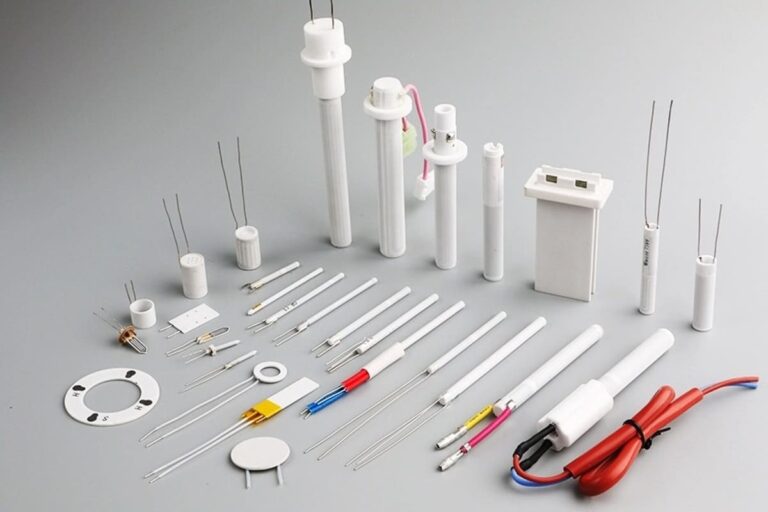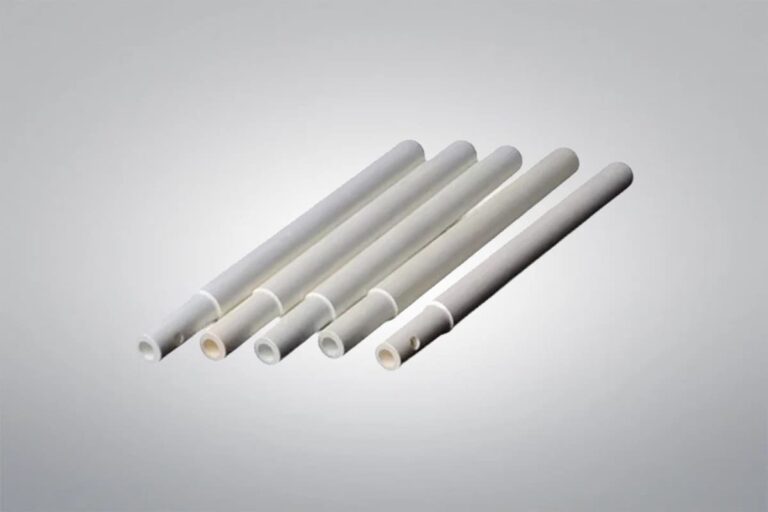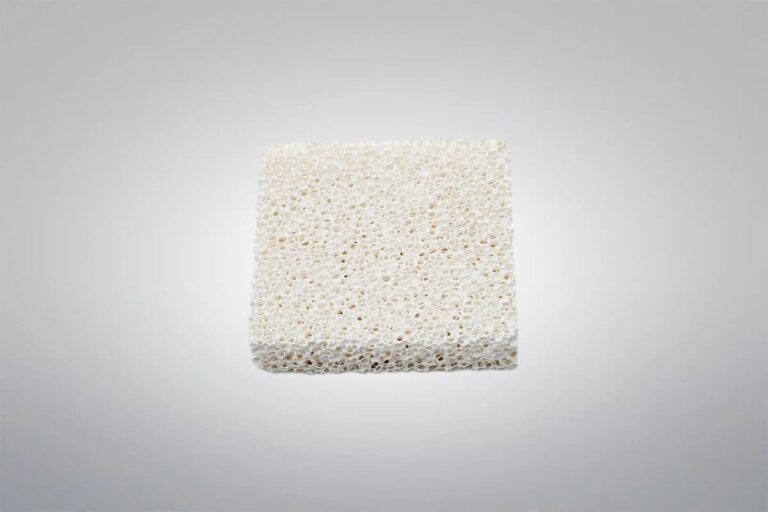Silicon Carbide Crucible

Silicon Carbide Crucible
Purity: ≥99%
Silicon Carbide Crucible is made from high-purity silicon carbide (SiC), offering exceptional high-temperature resistance, thermal shock resistance, and chemical corrosion resistance. It is widely used in non-ferrous metal melting, semiconductor crystal growth, and high-temperature research. As a leading supplier and manufacturer of premium silicon carbide products, we can supply high-quality silicon carbide crucibles with various specifications and competitive prices, offering customized solutions to meet specific requirements.
Or email us at sales@heegermaterials.com.Silicon Carbide Crucible Data Sheet
| Reference Code: | HM2575 |
| Purity: | ≥99% |
| Color: | Black or Dark grey |
| Chemical Formula: | SiC |
| Material Grades: | Reaction Bonded SiC, Pressureless Sintered SiC, Hot-pressed SiC, etc. |
| Shape: | Cylinder, Conical Cylinder, Rectangular, T-shape, or Customized according to specific drawings |
| Density: | >3.2 g/cm³ |
| Maximum Operating Temperature: | 1600°C |
| Thermal Conductivity: | 120-200 W/m·K |
Silicon Carbide Crucible Description
Silicon Carbide (SiC) primarily exists in two crystal structures: the cubic β-SiC and the hexagonal α-SiC. Compared to other ceramics such as alumina (Al2O3) and boron carbide (B4C), SiC exhibits superior mechanical properties, better oxidation resistance, higher wear resistance, and a lower friction coefficient. Silicon Carbide Crucible is made from high-purity silicon carbide (SiC), featuring high thermal conductivity (120-200 W/m·K) and low thermal expansion. It ensures rapid and uniform heating while minimizing crack risks. Advanced Ceramics Hub can supply high-precision silicon carbide crucibles with customized solutions for diverse industry and research applications.
Silicon Carbide Crucible Specifications
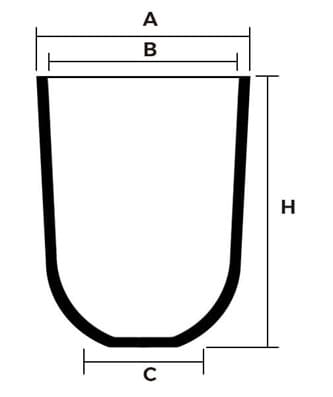
| A ± 5mm | B ± 5mm | C ± 10mm | H ± 10mm |
| 170 | 130 | 115 | 220 |
| 170 | 130 | 115 | 260 |
| 205 | 162 | 130 | 265 |
| 240 | 200 | 170 | 335 |
| 270 | 210 | 180 | 335 |
| 290 | 230 | 225 | 340 |
| 295 | 240 | 225 | 400 |
| 305 | 248 | 150 | 345 |
| 310 | 255 | 170 | 345 |
Silicon Carbide Crucible Features
- High Thermal Conductivity: Silicon carbide crucibles are made from heat-conductive materials. Their compact structure and low apparent porosity allow for fast heat transfer.
- Durability: The same material can extend the lifespan of conventional graphite crucibles up to two times.
- High Density: Thanks to advanced isostatic pressing technology, the material is uniform, flawless, and dense.
- High Strength: Silicon carbide crucibles feature excellent material selection, high pressing temperatures, good thermal strength, scientifically designed shapes, and strong load-bearing capacity.
- Corrosion Resistance: The complex composition of the crucible material allows it to withstand both physical and chemical corrosion from molten materials.
- Low Residue: The inner walls of the crucible have minimal material adhesion, eliminating thermal resistance, which significantly reduces the risk of crucible cracking.
Silicon Carbide Crucible Applications
- Metal Smelting: Silicon carbide crucibles are commonly used for melting precious metals, aluminum, copper, steel, and other metals. Their high-temperature resistance allows them to operate stably in extreme environments for extended periods.
- Glass and Ceramic Manufacturing: In glass and ceramic production, silicon carbide crucibles are used to melt raw materials for glass or ceramics, helping to improve production efficiency and material quality.
- Chemical Experiments: Silicon carbide crucibles are often used in chemical laboratories for high-temperature reactions, suitable for handling highly corrosive substances.
- Semiconductor Manufacturing: In the semiconductor industry, silicon carbide crucibles are used for crystal growth and material processing, providing stable melting conditions, especially in high-temperature environments.
- Casting Industry: Silicon carbide crucibles are also widely applied in the casting industry to melt alloys and maintain a stable molten state.
Silicon Carbide Material Properties
Silicon Carbide Material Grades
Reaction bonded silicon carbide (RBSiC) is made by mixing SiC, carbon, and binder, then infiltrating with silicon at high temperature. The vapor-phase method reduces free silicon to under 10%, improving performance. The result is a silicon-silicon carbide composite (SiSiC), not pure SiC.
SiC powder + C powder + binder mixed → forming → drying → protective atmosphere for degassing → high-temperature silicon infiltration → post-processing.
Reaction Bonded SiC Advantages:
- Low sintering temperature
- Low production cost
- High material densification
- Carbon and silicon carbide framework can be pre-machined into any shape
- Shrinkage during sintering is within 3%, aiding dimension control
- Significant reduction in the need for finishing, ideal for large, complex components
Reaction Bonded SiC Disadvantages:
- Residual free silicon in the sintered body after processing
- Reduced strength compared to products from other processes
- Decreased wear resistance
- Free silicon is not resistant to corrosion from alkaline substances and strong acids (e.g., hydrofluoric acid)
- Limited usage due to corrosion susceptibility
- High-temperature strength is impacted by free silicon
- Typical usage temperature is limited to below 1350-1400°C
Pressureless sintered silicon carbide refers to the densification sintering of samples with varying shapes and sizes at 2000–2150°C without applying external pressure and using an inert gas atmosphere, by incorporating suitable sintering additives. The sintering process can be categorized into solid-phase sintering (SSiC) and liquid-phase sintering (LSiC).
Solid-Phase Sintering SiC (SSiC) Properties:
- High Sintering Temperature: Requires a high sintering temperature (>2000°C).
- High Purity Requirement: The raw materials must be of high purity.
- Low Fracture Toughness: The sintered body has lower fracture toughness and tends to undergo transgranular fracture.
- Clean Grain Boundaries: There is essentially no liquid phase, and the grain boundaries are relatively “clean.”
- Stable High-Temperature Strength: High-temperature strength remains stable up to 1600°C without significant changes.
- Grain Growth: At high temperatures, grain growth is easy, leading to poor grain uniformity.
- High Crack Sensitivity: The material is highly sensitive to crack strength.
Liquid-Phase Sintering SiC (LSiC) Properties:
- Lower Sintering Temperature: Compared to solid-state sintering, the sintering temperature is lower.
- Smaller Grain Size: The grain size is smaller, with better uniformity of grains.
- Improved Fracture Toughness: Due to the introduction of a liquid phase at the grain boundaries, the fracture mode shifts to intergranular fracture, significantly improving fracture toughness.
- Additive Influence: Uses multi-component eutectic oxides (e.g., Y2O3-Al2O3) as sintering additives, promoting densification.
- Reduced Crack Sensitivity: Liquid-phase sintering reduces the material’s sensitivity to crack strength.
- Weakened Interface Bonding: The introduction of the liquid phase weakens the bonding strength at the grain boundaries.
Pressureless sintered boron carbide combines high purity and the excellent mechanical properties of boron carbide for use in both ballistic armor and semiconductor manufacturing.
Hot-Pressed SiC Advantages:
- Enables sintering at lower temperatures and shorter times, resulting in fine grains, high relative density, and good mechanical properties.
- The simultaneous heating and pressing facilitate particle contact diffusion and mass transfer.
- Suitable for producing silicon carbide ceramics with good mechanical performance.
Hot-Pressed SiC Disadvantages:
- The equipment and process are complex.
- High demands on mold material.
- Limited to producing simple-shaped parts.
- Low production efficiency.
- High production costs.
Recrystallized Silicon Carbide (RSiC) is a pure silicon carbide ceramic made via high-temperature evaporation-condensation, with a porous, high-strength structure, offering excellent heat, corrosion, and thermal shock resistance, used in kiln furniture, nozzles, and chemical components.
Recrystallized SiC Properties & Applications:
- The sintering process, based on evaporation-condensation, doesn’t cause shrinkage, preventing deformation or cracking.
- RSiC can be shaped through methods like casting, extrusion, and pressing, and its shrinkage-free firing allows for precise dimensions.
- After firing, recrystallized RSiC contains 10%-20% residual porosity, primarily influenced by the green body’s porosity, providing a foundation for porosity control.
- The sintering mechanism creates interconnected pores, making RSiC suitable for applications in exhaust and air filtration.
- RSiC has clean grain boundaries, free from glass and metal impurities, ensuring high purity and retaining SiC’s superior properties for demanding high-performance applications.
Hot Isostatic Pressed Silicon Carbide (HIPSiC) is a high-performance ceramic produced via hot isostatic pressing. Under high temperature (around 2000 ℃) and uniform high-pressure gas (typically argon), silicon carbide powder is densified into a nearly pore-free structure.
Hot Isostatic Pressed SiC Advantages:
- Uniform mictrostructure and fine grain size
- Low sintering temperature and time
- High density
- High purity and component control
Hot Isostatic Pressed SiC Disadvantages:
- Difficult packaging technology
- High initial investment and operational costs
- Limited for large or complex shapes
Spark Plasma Sintering Silicon Carbide is a high-performance ceramic produced using spark plasma sintering technology. This process employs pulsed current and pressure to rapidly density silicon carbide powder at relatively low temperatures (around 1800-2000 ℃) in a short time.
Spark Plasma Sintering SiC Properties:
- Faster heating rate
- Lower sintering temperature
- Shorter sintering time
- Fine and uniform grains
- High density
- Appliable for small and precision parts
Silicon Carbide Ceramic Machining

Silicon Carbide (SiC) is a highly durable ceramic material with extreme hardness (9.5 Mohs), thermal stability (up to 1650 ℃), and resistance to wear, corrosion, and high temperatures. However, machining silicon carbide presents challenges due to its extreme hardness and brittleness. Specialized techniques and tools are required to achieve precise cuts and shapes. The common machining methods include:
- Diamond Grinding: Diamond tools are used to achieve smooth surfaces and precise shapes.
- Laser Cutting: Suitable for cutting thin SiC materials. Laser cutting offers high precision and minimal material waste.
- Ultrasonic Machining: This method uses high-frequency vibrations to cut and shape brittle materials like SiC without causing cracks.
- Electrical Discharge Machining (EDM): A non-traditional method that uses electrical sparks to remove material, effective for hard ceramics like SiC.
- Grinding With CBN Tools: Cubic boron nitride (CBN) tools can be used for grinding SiC, providing an alternative to diamond grinding for certain applications.
- Water Jet Cutting: Using a high-pressure jet of water, sometimes with abrasive particles, to cut through SiC. This method is useful for cutting complex shapes.
Silicon Carbide Ceramic Packaging
Silicon Carbide ceramic products are typically packaged in vacuum-sealed bags to prevent moisture or contamination and wrapped with foam to cushion vibrations and impacts during transport, ensuring the quality of products in their original condition.
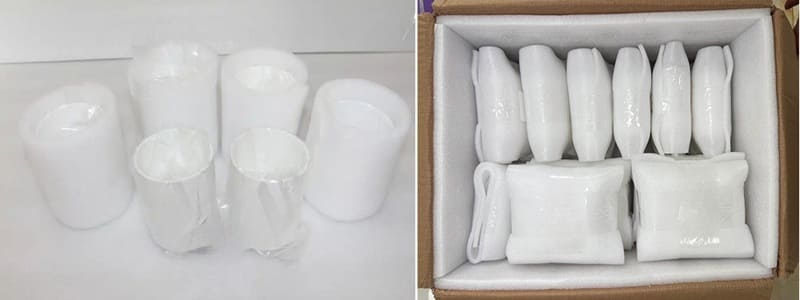
Download
Get A Quote
We will check and get back to you in 24 hours.


